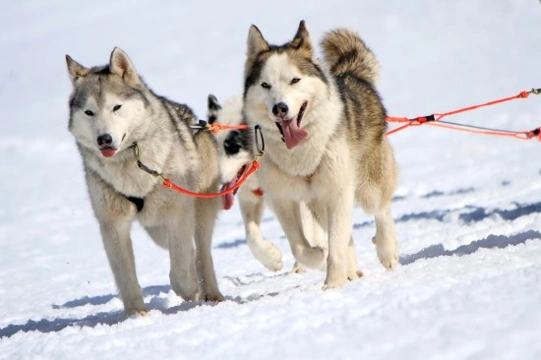
More about sled dog breeds
Sled dogs, or sleigh dogs as they are sometimes known, are dog breeds that were traditionally bred and used for pulling sleighs across large distances of frozen, inhospitable terrain. In many parts of the world, sled dogs are still widely used today, although sled dogs are also now commonly kept as domestic pets all over the world, in countries of all types and often far-flung from their frozen origins!
The use of sled dogs for hobby racing and competitive sledding competitions is also popular today, and sled dogs of all types are hardy, versatile and energetic, and able to turn their paws to a wide range of different activities.
Read on to learn more about the sled dog breeds of the world.
Siberian Husky
The Siberian Husky is the sled dog breed that you are most likely to see kept as a pet within the UK today, and these friendly, outgoing and entertaining dogs are in demand as pets all over the world. Originating in the frozen east of Russia, the Siberian Husky has superior stamina and endurance, and can run all day without tiring. More information on the Siberian Husky can be found in this article.
Alaskan Husky
The Alaskan Husky is the type of sled dog most commonly used for sled dog racing today, and technically speaking, the Alaskan Husky is a mongrel that is selectively bred for their sleigh-pulling and racing ability. The Alaskan Husky is sometimes referred to as the “Indian Dog,” and it is believed that the dog we call the Alaskan Husky today originated as a Native American village dog. The Alaskan Husky does not share the general similarities in appearance that denote most of the other sled dog breeds, despite sharing a similar genetic ancestry.
Due to the variable nature of the makeup of the breeding of any Alaskan Husky, their temperaments and individual traits can be highly variable.
Alaskan Malamute
The Alaskan Malamute is thought to be one of the very earliest domesticated breeds of dog, and they fall into the sled-dog sub category of freight dogs, dogs which are used to pull sleds of heavy equipment over long distances. The emphasis of the Alaskan Malamute is endurance and pulling ability, and they are not among the fastest of the sled dog breeds.
The Alaskan Malamute is still mainly used as a working sled dog, and they are not commonly kept as lone family pets, preferring to live as part of a pack.
Canadian Eskimo Dog
The Canadian Eskimo Dog hails from arctic Canada, and was also used as a hunting dog to help the original inhabitants of arctic Canada to catch prey as large as seals and polar bears! The Canadian government had a significant amount of input into the development of the breed as we know it today, but the Canadian Eskimo Dog was originally used as a sled dog by the Thule people of arctic Canada.
The Canadian Eskimo dog is renowned for developing a strong bond with their owners, and are brave, loyal and intelligent, as well as gentle and affectionate.
Chinook
The Chinook was developed in New Hampshire in the 1900’s, and is comprised of a mixture of German Shepherd, Belgian Shepherd, Greenland Husky and Mastiff origins. It only recently gained recognition as an official breed with the American Kennel Club, where it is registered as a working dog breed. They are renowned for their athletic ability and tirelessness over long distances, and are also the state dog of New Hampshire.
The Chinook dog is very playful and highly affectionate, and has a particular affinity with children. They are also generally highly social with other dogs of all breeds, and enjoy being part of a pack.
Greenland Dog
The Greenland Dog is an Eskimo dog from Greenland, with plenty of endurance for travelling over long distances but not a particularly fast turn of speed. They are commonly used in Greenland by companies that offer tourist expeditions and sled dog tours, and it is estimated that there are over 30,000 of these dogs kept in Greenland! They are also the primary means of transportation in winter in Greenland, and remain more popular than mechanical snowmobiles, as Greenland sled dog teams are found over all to be more reliable!
The Greenland dog today usually lives in similar circumstances to their historical ancestors; they are working dogs and pack dogs first and foremost, and rarely kept as non-working domestic pets.
Samoyed
The Samoyed hails from Siberia, where it was developed by the natives of the region to haul sleds, herd reindeer, and help with hunting. Unusually for dogs owned by early civilisations, the Samoyed was permitted to sleep with their owners in their homes rather than outside, indicating how highly prized the Samoyed was by their owners.
The Samoyed is extremely outgoing and friendly and good with people of all ages, and they are rarely aggressive and reputed to be very quiet dogs that rarely bark.



